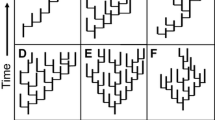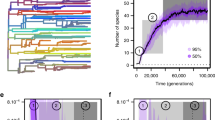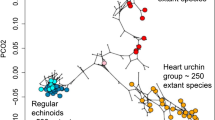Abstract
Recently, new phylogenetic comparative methods have been proposed to test for the association of biological traits with diversification patterns, with species ecological “niche” being one of the most studied traits. In general, these methods implicitly assume natural selection acting at the species level, thus implying the mechanism of species selection. However, natural selection acting at the organismal level could also influence diversification patterns (i.e., effect macroevolution). Owing to our scarce knowledge on multi-level selection regarding niche as a trait, we propose a conceptual model to discuss and guide the test between species selection and effect macroevolution within a hierarchical framework. We first assume niche as an organismal as well as a species’ trait that interacts with the environment and results in species-level differential fitness. Then, we argue that niche heritability, a requirement for natural selection, can be assessed by its phylogenetic signal. Finally, we propose several predictions that can be tested in the future by disentangling both types of evolutionary processes (species selection or effect macroevolution). Our framework can have important implications for guiding analyses that aim to understand the hierarchical perspective of evolution.



Similar content being viewed by others
References
Araújo, M. S., Bolnick, D. S., & Layman, C. A. (2011). The ecological causes of individual specialization. Ecology Letters, 14, 948–958.
Barraclough, T. G., & Vogler, A. P. (2000). Detecting the geographical pattern of speciation from species‐level phylogenies. American Naturalist, 155, 419–434.
Birand, A., Vose, A., & Gavrilets, S. (2012). Patterns of species ranges, speciation, and extinction. The American Naturalist, 179, 1–21.
Bolnick, D. I., Svanback, R., Fordyce, J. A., Yang, L. H., Davis, J. M., Hulsey, C. D., et al. (2003). The ecology of individuals: incidence and implications of individual specialization. American Naturalist, 161, 1–28.
Burin, G., Kissling, W.D., Guimarães Jr, P.R., Şekercioğlu, Ç.H., & Quental, T.B. (2016). Omnivory in birds is a macroevolutionary sink. Nature Communications, 7.
Cardillo, M. (2015). Geographic range shifts do not erase the historic signal of speciation in mammals. The American Naturalist, 185, 343–353.
Cavender‐Bares, J., Kozak, K. H., Fine, P. V., & Kembel, S. W. (2009). The merging of community ecology and phylogenetic biology. Ecology Letter, 12, 693–715.
Ceballos, G., & Ehrlich, P. R. (2002). Mammal population losses and the extinction crisis. Science, 296, 904–907.
Chevin, L. M. (2016). Species selection and random drift in macroevolution. Evolution, 70, 513–525.
Colwell, R. K., & Rangel, T. F. (2009). Hutchinson’s duality: the once and future niche. Proceedings of the National Academy of Science of the United States of America, 106, 19651–19658.
Darwin, C. (1859). On the origin of species. London: J. Murray.
DeAngelis, D. L., & Mooij, W. M. (2005). Individual-based modeling of ecological and evolutionary processes. Annual Review of Ecology, Evolution, and Systematics, 36, 147–168.
Diniz-Filho, J. A. F. (2004). Macroecology and the hierarchical expansion of evolutionary theory. Global Ecology and Biogeography, 13, 1–5.
Diniz-Filho, J. A. F., Terribile, L. C., Da Cruz, M. J. R., & Vieira, L. C. G. (2010). Hidden pattern of phylogenetic non-stationarity overwhelm comparative analyses of niche conservatism and divergence. Global Ecology and Biogeography, 19, 916–926.
Diniz‐Filho, J. A. F., Alves, D. M. C. C., Villalobos, F., Sakamoto, M., Brusatte, S. L., & Bini, L. M. (2015). Phylogenetic eigenvectors and non‐stationarity in the evolution of theropod dinosaur skulls. Journal of Evolutionary Biology, 28, 1410–1416.
Eldredge, N., & Gould, S. J. (1972). Punctuated equilibria: an alternative to phyletic gradualism. In T. J. M. Schopf (Ed.), Models in Paleobiology (pp. 82–115). San Francisco: Freeman, Cooper and Company.
Felsenstein, J. (1985). Phylogenies and the comparative method. American Naturalist, 125, 1–15.
Freckleton, R. P., Harvey, P. H., & Pagel, M. (2002). Phylogenetic analysis and comparative data: a test and review of evidence. The American Naturalist, 160, 712–726.
Gascuel, F., Ferrière, R., Aguilée, R., & Lambert, A. (2015). How ecology and landscape dynamics shape phylogenetic trees. Systematic Biology, 64, 590–607.
Goldberg, E. E., Kohn, J. R., Lande, R., Robertson, K. A., Smith, S. A., & Igić, B. (2010). Species selection maintains self-incompatibility. Science, 330, 493–495.
Gómez‐Rodríguez, C., Baselga, A., & Wiens, J. J. (2015). Is diversification rate related to climatic niche width? Global Ecology and Biogeography, 24, 383–395.
Gould, S. J. (1982). Darwinism and the expansion of evolutionary theory. Science, 216, 380–386.
Grimm, V., & Railsback, S. F. (2005). Individual-based modeling and ecology. New Jersey: Princeton University Press.
Harvey, P. H., & Pagel, M. D. (1991). The comparative method in evolutionary biology. Oxford: Oxford University Press.
Hubbell, S. P. (2001). The unified neutral theory of biodiversity and biogeography. New Jersey: Princeton University Press.
Hutchinson, G. E. (1957). Concluding remarks. Cold Spring Harbor Symposium on Quantitative Biology, 22, 415–427.
Hutchinson, G. E. (1978). An introduction to population ecology. Yale University Press.
Jablonski, D. (1987). Heritability at the species level: analyses of geographic ranges of Cretaceous Mollusks. Science, 238, 360–363.
Jablonski, D. (2007). Scale and hierarchy on macroevolution. Paleontology, 50, 87–109.
Jablonski, D. (2008). Species selection: theory and data. Annual Review of Ecology, Evolution, and Systematics, 39, 501–524.
Kozak, K. H., & Wiens, J. J. (2010). Accelerated rates of climatic‐niche evolution underlie rapid species diversification. Ecology Letters, 13, 1378–1389.
Lewontin, R. C. (1970). The units of selection. Annual Review of Ecology and Systematics, 1, 1–18.
Lieberman, B. S., & Vrba, E. S. (2005). Stephen Jay Gould on species selection: 30 years of insight. Paleobiology, 31, 113–121.
Lloyd, E. A., & Gould, S. J. (1993). Species selection on variability. Proceedings of the National Academy of Science of the United States of America, 90, 595–599.
Losos, J. B. (2008). Phylogenetic niche conservatism, phylogenetic signal and the relationship between phylogenetic relatedness and ecological similarity among species. Ecology Letters, 11, 995–1007.
Machac, A., Zrzavý, J., & Storch, D. (2011). Range size heritability in Carnivora is driven by geographic constraints. The American Naturalist, 177, 767–779.
Maddison, W. P., Midford, P. E., & Otto, S. P. (2007). Estimating a binary character's effect on speciation and extinction. Systematic biology, 56, 701–710.
Marquet, P. A., & Taper, M. L. (1998). On size and area: patterns of mammalian body size extremes across landmasses. Evolutionary Ecology, 12, 127–139.
Maurer, B. A. (1998). The evolution of body size in birds. I. Evidence for non-random diversification. Evolutionary Ecology, 12, 925–934.
Mayr, E. (1963). Animal species and evolution. Cambridge: Belknap Press of Harvard University Press.
McInerny, G. J., & Etienne, R. S. (2012). Stitch the niche—a practical philosophy and visual schematic for the niche concept. Journal of Biogeography, 39, 2103–2111.
Morlon, H. (2014). Phylogenetic approaches for studying diversification. Ecology letters, 17, 508–525.
Myers, C. E., & Saupe, E. E. (2013). A macroevolutionary expansion of the modern synthesis and the importance of extrinsic abiotic factors. Palaeontology, 56, 1179–1198.
Ozinga, W. A., Colles, A., Bartish, I. V., Hennion, F., Hennekens, S. M., Pavoine, S., Poschlod, P., Hermant, M., Schaminée, J. H. J., & Prinzing, A. (2013). Specialists leave fewer descendants within a region than generalists. Global Ecology and Biogeography, 22, 213–222.
Pearman, P. B., Guisan, A., Broennimann, O., & Randin, C. F. (2008). Niche dynamics in space and time. Trends in Ecology & Evolution, 23, 149–158.
Pennell, M. W., & Harmon, L. J. (2013). An integrative view of phylogenetic comparative methods: connections to population genetics, community ecology, and paleobiology. Annals of the New York Academy of Science, 1289, 90–105.
Peterson, A. T., & Soberón, J. (2012). Species distribution modeling and ecological niche modeling: getting the concepts right. Natureza & Conservação, 10, 102–107.
Price, S. A., Hopkins, S. S., Smith, K. K., & Roth, V. L. (2012). Tempo of trophic evolution and its impact on mammalian evolution. Proceedings of the National Academy of Science of the United States of America, 109, 7008–7012.
Pyron, R. A., & Wiens, J. J. (2013). Large-scale phylogenetic analyses reveal the causes of high tropical amphibian diversity. Proceedings of the Royal Society of London B, 280, 1–10.
Quintero, I., & Wiens, J. J. (2013). What determines the climatic niche width of species? The role of spatial and temporal climatic variation in three vertebrate clades. Global Ecology and Biogeography, 22, 422–432.
Rabosky, D. L., & Goldberg, E. E. (2015). Model inadequacy and mistaken inferences of trait-dependent speciation. Systematic Biology, 64, 340–355.
Rabosky, D. L., & McCune, A. R. (2009). Reinventing species selection with molecular phylogenies. Trends in Ecology and Evolution, 25, 68–74.
Reed, D. H., Lowe, E. H., Briscoe, D. A., & Frankham, R. (2003). Inbreeding and extinction: effects of rate of inbreeding. Conservation genetics, 4, 405–410.
Reed, D. H. (2005). Relationship between population size and fitness. Conservation Biology, 19, 563–568.
Revell, L. J., Harmon, L. J., & Collar, D. C. (2008). Phylogenetic signal, evolutionary process, and rate. Systematic Biology, 57, 591–601.
Rojas, D., Vale, Á., Ferrero, V., & Navarro, L. (2012). The role of frugivory on the diversification of bats in the Neotropics. Journal of Biogeography, 39, 1948–1960.
Rolland, J., & Salamin, N. (2016). Niche width impacts vertebrate diversification. Global Ecology and Biogeography. doi:10.1111/geb.12482.
Rosindell, J., Harmon, L. J., & Etienne, R. S. (2015). Unifying ecology and macroevolution with individual‐based theory. Ecology Letters, 18, 472–482.
Simpson, G. G. (1944). Tempo and mode in evolution. New York: Columbia University Press.
Slatyer, R. A., Hirst, M., & Sexton, J. P. (2013). Niche breadth predicts geographical range size: a general ecological pattern. Ecology Letters, 16, 1104–1114.
Soberón, J. (2007). Grinnellian and Eltonian niches and geographic distributions of species. Ecology Letters, 10, 1115–1123.
Soberón, J. (2014). Commentary on Ditch, Stitch and Pitch: the niche is here to stay. Journal of Biogeography, 41, 414–417.
Soberón, J., & Nakamura, M. (2009). Niches and distributional areas: concepts, methods, and assumptions. Proceedings of the National Academy of Science of the United States of America, 106, 19644–19650.
Soberón, J., & Peterson, A. T. (2005). Interpretation of models of fundamental ecological niches and species’ distributional areas. Biodiversity Informatics, 2, 1–10 (2005). doi:10.17161/bi.v2i0.4.
Stanley, S. M. (1975). A theory of evolution above the species level. Proceedings of the National Academy of Science of the United States of America, 72, 646–650.
Thuiller, W., Lavorel, S., & Araújo, M. B. (2005). Niche properties and geographical extent as predictors of species sensitivity to climate change. Global Ecology and Biogeography, 14, 347–357.
Title, P. O., & Burns, K. J. (2015). Rates of climatic niche evolution are correlated with species richness in a large and ecologically diverse radiation of songbirds. Ecology Letters, 18, 433–440.
Vrba, E. S. (1987). Ecology in relation to speciation rates: some case histories of Miocene-Recent mammal clades. Evolutionary Ecology, 1, 283–300.
Vrba, E. S., & Eldredge, N. (1984). Individuals, hierarchies and processes: towards a more complete evolutionary theory. Paleobiology, 10, 146–171.
Vrba, E. S., & Gould, S. J. (1986). The hierarchical expansion of sorting and selection: sorting and selection cannot be equated. Paleobiology, 12, 217–228.
Webb, T. J., & Gaston, K. J. (2003). On the heritability of geographic range sizes. The American Naturalist, 161, 553–566.
Wiens, J. J. (2008). Comentary on Losos (2008): niche conservatism déjà vu. Ecology Letters, 11, 995–1007.
Wiens, J. J., Ackerly, D. D., Allen, A. P., Anacker, B. L., Buckley, L. B., Cornell, H. V., et al. (2010). Niche conservatism as an emerging principle in ecology and conservation biology. Ecology Letters, 13, 1310–1324.
Wilson, D. S., & Yoshimura, J. (1994). On the coexistence of specialists and generalists. American Naturalist, 144, 692–707.
Wright, S. (1943). Isolation by distance. Genetics, 28, 114.
Acknowledgments
We are indebted to Thiago F. Rangel and Tiago B. Quental for thorough discussions and suggestions. We thank Michael Schmitt for grateful suggestions in the manuscript. FV thanks Mark E. Olson for introducing him to macroevolutionary theory and for endless discussions on theory and science. DMCCA was supported by a “Coordenação de Aperfeiçoamento de Pessoal de Nível Superior” (CAPES) doctoral fellowship. FV was supported by a “Conselho Nacional de Desenvolvimento Científico e Tecnológico” (CNPq) Science without Borders grant (BJT 301540/2014-4). JAFDF is continuously supported by a “Conselho Nacional de Desenvolvimento Científico e Tecnológico” (CNPq) productivity fellowship.
Author information
Authors and Affiliations
Corresponding author
Rights and permissions
About this article
Cite this article
Alves, D.M.C.C., Diniz-Filho, J.A.F. & Villalobos, F. Integrating selection, niche, and diversification into a hierarchical conceptual framework. Org Divers Evol 17, 1–10 (2017). https://doi.org/10.1007/s13127-016-0299-x
Received:
Accepted:
Published:
Issue Date:
DOI: https://doi.org/10.1007/s13127-016-0299-x




